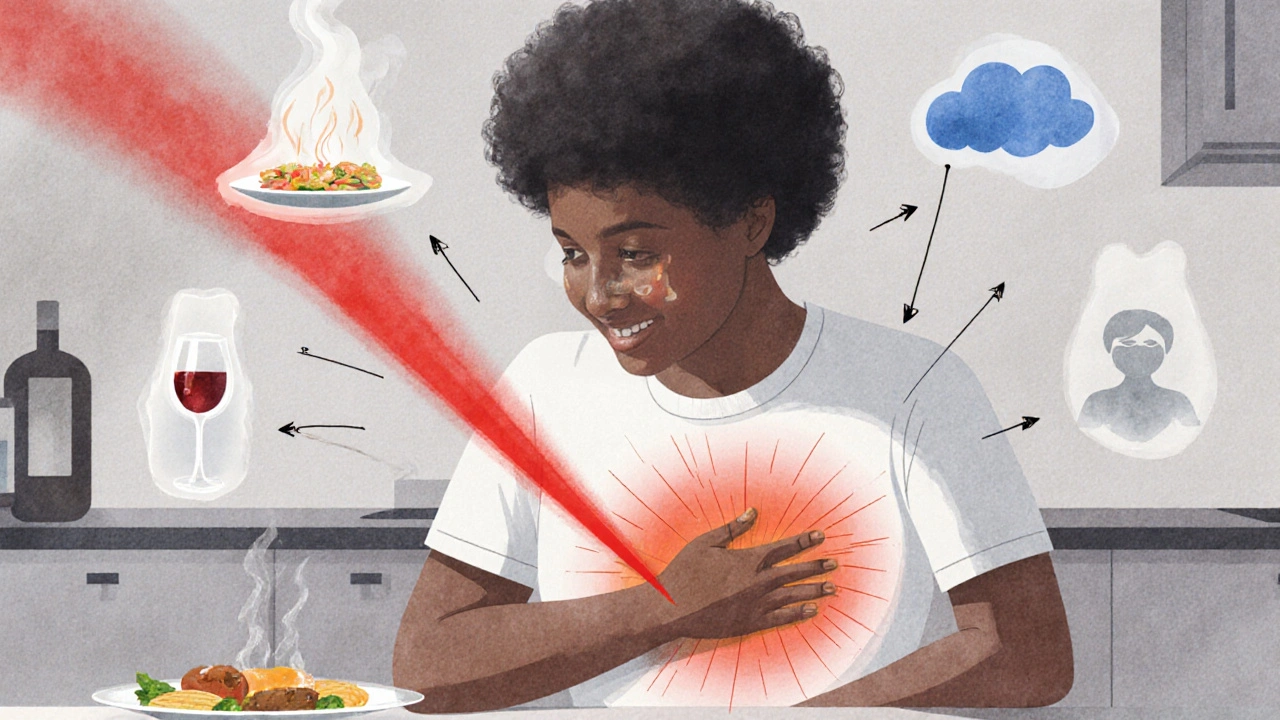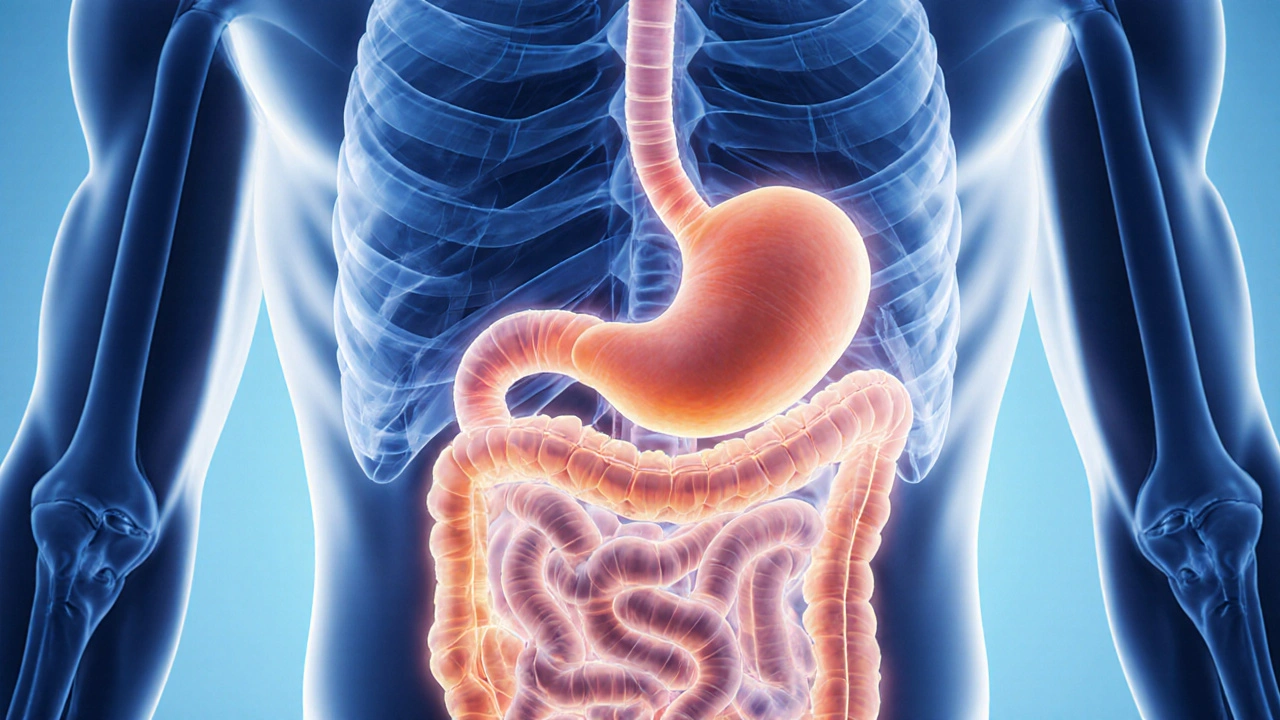Epigastric Pain Symptom Checker
When you feel a burning or aching sensation just under your breastbone, you’re likely experiencing epigastric pain, a type of upper abdominal discomfort that can signal anything from harmless indigestion to serious organ inflammation. This guide breaks down why the pain happens, what other signs to watch for, and how you can get relief without endless web searches.
Quick Summary
- Epigastric pain is discomfort in the upper central abdomen, often linked to the stomach, esophagus, gallbladder, or pancreas.
- Common triggers include acid reflux, ulcers, gallstones, and pancreatitis.
- Red‑flag symptoms-sudden severe pain, fever, vomiting blood, or pain spreading to the back-require urgent medical care.
- Diagnosis typically starts with a physical exam, then blood tests, ultrasound, or endoscopy.
- Treatment ranges from lifestyle tweaks and over‑the‑counter antacids to prescription medications and, in rare cases, surgery.
What Exactly Is Epigastric Pain?
The epigastrium is the region on the front of the body, between the lower ribs and the belly button. Pain here can feel like a dull ache, a sharp stab, or a burning sensation. Because many organs share this space, the source isn’t always obvious.
In medical terms, epigastric pain refers to discomfort localized in the upper central abdomen, often reflecting issues in the stomach, esophagus, gallbladder, pancreas, or surrounding tissues. Understanding which organ is involved guides the right treatment.
Common Causes and How to Spot Them
Below are the most frequent culprits, their typical pain patterns, and a quick way to differentiate them.
| Cause | Typical Pain Quality | Associated Symptoms | Key Diagnostic Test |
|---|---|---|---|
| Gastroesophageal reflux disease (GERD) | Burning, worsens after meals or lying down | Heartburn, sour taste, regurgitation | Upper endoscopy or pH monitoring |
| Peptic ulcer disease | Gnawing, night‑time pain, relieved by food | Dark stools, nausea | Endoscopy, H. pylori test |
| Gallstones (biliary colic) | Sharp, episodic, radiates to right shoulder | Jaundice, fatty food trigger | Abdominal ultrasound |
| Pancreatitis | Constant, radiates to back, worsens after alcohol or fatty meals | Fever, vomiting, elevated lipase | Serum lipase, CT scan |
| Gastritis | Burning, often after NSAID use or alcohol | Loss of appetite, bloating | Endoscopy, biopsy |
| Non‑ulcer dyspepsia | Mild, vague discomfort | Stress‑related, no clear red flags | Diagnosis of exclusion |
Notice how the pain’s timing, triggers, and accompanying signs give clues about the underlying organ.
Red‑Flag Symptoms: When to Call a Doctor Immediately
Most epigastric discomfort can be managed at home, but certain signs suggest a medical emergency:
- Sudden, severe pain that doesn’t improve after 15 minutes
- Vomiting blood or material that looks like coffee grounds
- Black, tarry stools (possible GI bleed)
- Fever over 38°C (100.4°F) with abdominal pain
- Pain spreading to the back, shoulder, or jaw
- Difficulty breathing or shortness of breath
If any of these appear, seek emergency care. Delays can lead to complications such as perforated ulcer or pancreatic necrosis.

How Doctors Figure Out the Cause
The diagnostic pathway starts simple and gets more detailed if needed.
- Medical history and physical exam: Your doctor asks about food habits, medication use (especially NSAIDs), alcohol intake, and stress levels. Palpation of the abdomen helps locate tenderness.
- Basic labs: Blood count, liver enzymes, and pancreatic enzymes (amylase, lipase) rule out infection or pancreatitis.
- Imaging: An abdominal ultrasound is fast for spotting gallstones or liver issues. If the picture is unclear, a CT scan offers a cross‑section view.
- Endoscopy: A thin camera slides down the esophagus and stomach, letting the doctor directly see ulcers, inflammation, or tumors. Biopsies can be taken for H. pylori testing.
- Special tests: For suspected GERD, a 24‑hour pH probe measures acid exposure. H. pylori breath or stool tests confirm infection without invasive procedures.
Each step adds a piece to the puzzle, narrowing the list of possible causes.
Treatment Paths Tailored to the Underlying Issue
Because the same pain can arise from different organs, treatment is never one‑size‑fits‑all.
Acid‑Related Conditions (GERD, Ulcers, Gastritis)
- Antacids: Quick relief by neutralizing stomach acid.
- H2‑blockers (e.g., ranitidine, famotidine): Reduce acid production for a few hours.
- Proton‑pump inhibitors (PPIs) (e.g., omeprazole, esomeprazole): The most potent acid suppressors, usually taken once daily for 4-8 weeks.
- Eradication therapy if H. pylori is present: A two‑drug antibiotic combo plus a PPI.
Biliary Issues (Gallstones, Biliary Colic)
- Low‑fat diet and occasional short‑term pain relievers.
- Ursodeoxycholic acid for dissolving small cholesterol stones (limited success).
- Cholecystectomy (gallbladder removal) is the definitive cure for recurrent attacks.
Pancreatitis
- Hospital admission for IV fluids, pain control, and fasting.
- Address underlying cause - stop alcohol, treat gallstones, or manage hypertriglyceridemia.
- Severe cases may need endoscopic or surgical drainage.
Non‑ulcer Dyspepsia & Functional Pain
- Small, frequent meals and avoidance of trigger foods (spicy, acidic, caffeinated).
- Probiotic supplements can improve gut flora balance.
- Low‑dose tricyclic antidepressants or SSRIs for pain modulation (prescribed by a physician).
Never self‑prescribe prescription meds; a proper diagnosis ensures you get the right therapy.
Practical Lifestyle Tweaks to Keep the Pain at Bay
Even after treatment, daily habits make a big difference.
- Eat mindfully: Chew slowly, avoid large meals, and limit late‑night snacking.
- Choose gentle foods: Oatmeal, bananas, boiled potatoes, and lean proteins are easy on the stomach.
- Limit irritants: Reduce NSAID use, alcohol, caffeine, and carbonated drinks.
- Stay upright after meals: A 30‑minute walk or sitting up prevents reflux.
- Manage stress: Techniques like deep‑breathing, yoga, or short meditation sessions can lower acid production.
These steps aren’t a cure‑all, but they reduce the chance that a minor irritation turns into chronic pain.
When to Seek Follow‑Up Care
After an initial visit, keep an eye on how you feel.
- If pain persists beyond two weeks despite treatment, ask for a repeat endoscopy or imaging.
- New symptoms-such as weight loss, persistent nausea, or worsening reflux-should trigger a re‑evaluation.
- For chronic conditions like GERD, schedule regular check‑ins to adjust medication dose and monitor for complications (e.g., Barrett’s esophagus).
Remember, early detection of serious problems like ulcer perforation or pancreatic cancer vastly improves outcomes.
Frequently Asked Questions
What is the difference between heartburn and epigastric pain?
Heartburn specifically describes a burning sensation that rises from the stomach into the chest, usually after eating or when lying down. Epigastric pain is broader-it includes any discomfort in the upper central abdomen, which can be caused by heartburn, ulcers, gallstones, or other organs.
Can stress really cause epigastric pain?
Yes. Stress increases stomach acid production and can aggravate conditions like gastritis and functional dyspepsia. While stress alone rarely damages organs, it often makes existing problems feel worse.
When should I get an endoscopy?
An endoscopy is recommended if you have persistent pain for more than two weeks, unexplained weight loss, bleeding, or if you’re at risk for ulcers (e.g., regular NSAID use or known H. pylori infection).
Are over‑the‑counter antacids safe for long‑term use?
Occasional use is fine, but chronic reliance can mask serious conditions and disrupt stomach acidity needed for digestion. If you need antacids most days of the week, see a doctor for a proper work‑up.
Can I exercise with epigastric pain?
Light activity, like walking, often helps digestion and reduces reflux. However, intense workouts that jolt the abdomen (e.g., heavy weight lifting) can worsen pain. Listen to your body and avoid activities that trigger symptoms.

Edward Webb
October 3, 2025 AT 23:20I can totally understand how unsettling epigastric discomfort can feel, especially when it interferes with daily life. While the guide does a solid job outlining possible causes, it’s also worth remembering that each individual’s experience varies. Think of it as a puzzle; the pieces include diet, stress, medication, and underlying health conditions. It helps to keep a simple journal of what you eat and how you feel, which can provide useful clues for your physician. Ultimately, a collaborative approach with your healthcare provider yields the best outcomes.
Snehal Suhane
October 14, 2025 AT 23:13Oh, behold the sheer marvel of a "comprehensive" guide that still manages to sound like a textbook from the 90s. The explanations are as deep as a puddle, and the suggestions? Definately more hype than help. If you wanted a proper breakdown, you'd need a doctorate, not this simplistic hype.
Ernie Rogers
October 25, 2025 AT 23:07This guide is just a bunch of buzzwords.
Eunice Suess
November 5, 2025 AT 22:00I must point out the misuse of “its” versus “it’s” in several places – a small error but it distracts the reader. Moreover, the tone swings dramatically from clinical to conversational, leaving the audience bewildered. It would benefit from stricter adherence to grammatical conventions. Still, the passion in the writing shines through, albeit with occasional over‑dramatics.
Anoop Choradia
November 16, 2025 AT 21:53One cannot overlook the possibility that much of the so‑called "medical consensus" is subtly guided by pharmaceutical interests. The guide, while thorough, omits any discussion of potential bias in the recommended treatments. It is prudent, therefore, to seek independent second opinions before embarking on any regimen. In a world where data can be curated, a healthy skepticism serves the patient best.
bhavani pitta
November 27, 2025 AT 21:47While the information presented is largely accurate, I find the emphasis on acid‑related conditions somewhat narrow. Many readers might benefit from a broader discussion of functional disorders that do not fit neatly into the classic categories. Additionally, the guide could have explored dietary cultural variations more extensively. Nonetheless, the content remains valuable for a general audience.
Brenda Taylor
December 8, 2025 AT 21:40Seriously, the world would be a better place if everyone read this and stopped ignoring their bodies 😊. Ignoring these signs is just reckless, and we should all take responsibility for our health. If you’re still unsure, just get checked – no excuses.